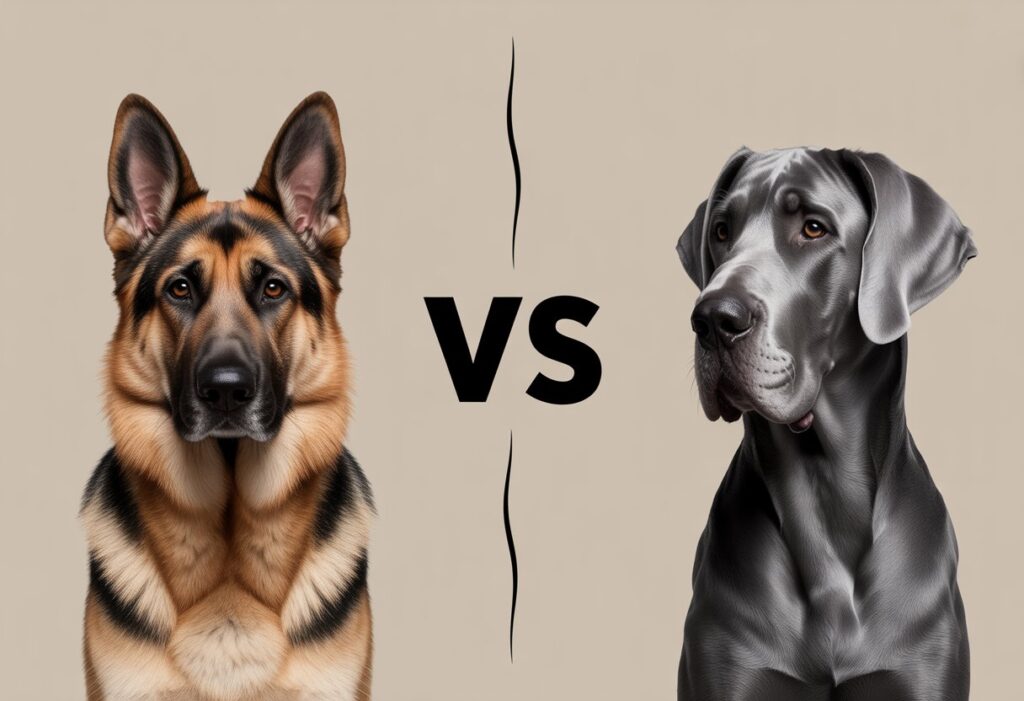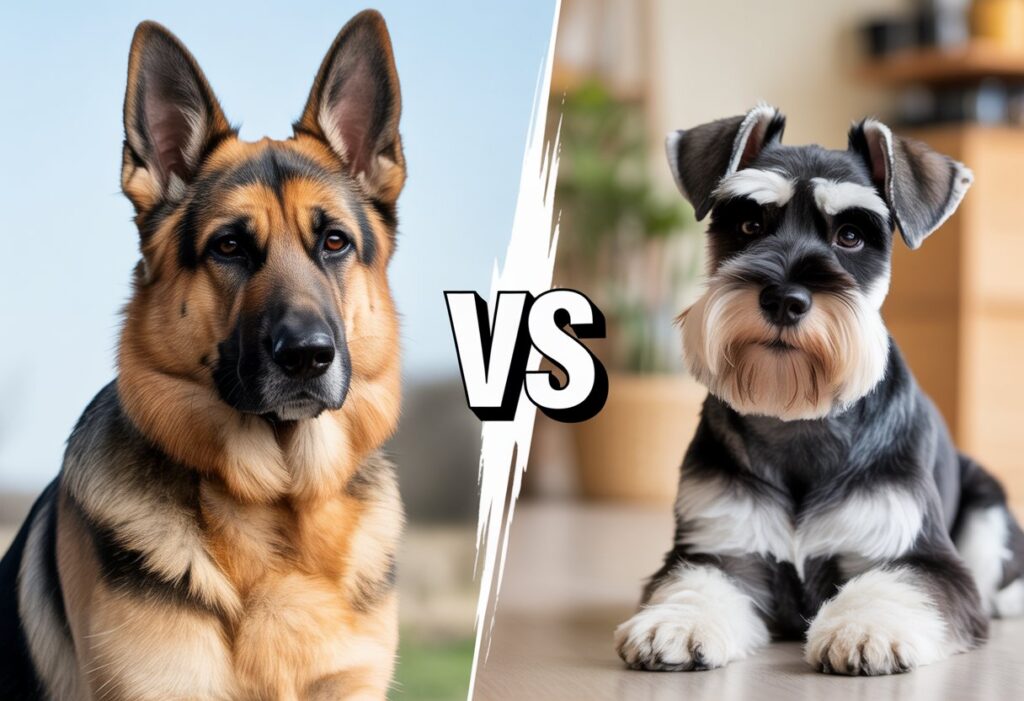Thinking about bringing a German Shepherd or a Great Dane into your home? German Shepherds are energetic, loyal, and protective.
Great Danes stand out for their gentle temperament and impressive size. Both breeds have unique traits, so it’s worth figuring out which one fits your lifestyle best.
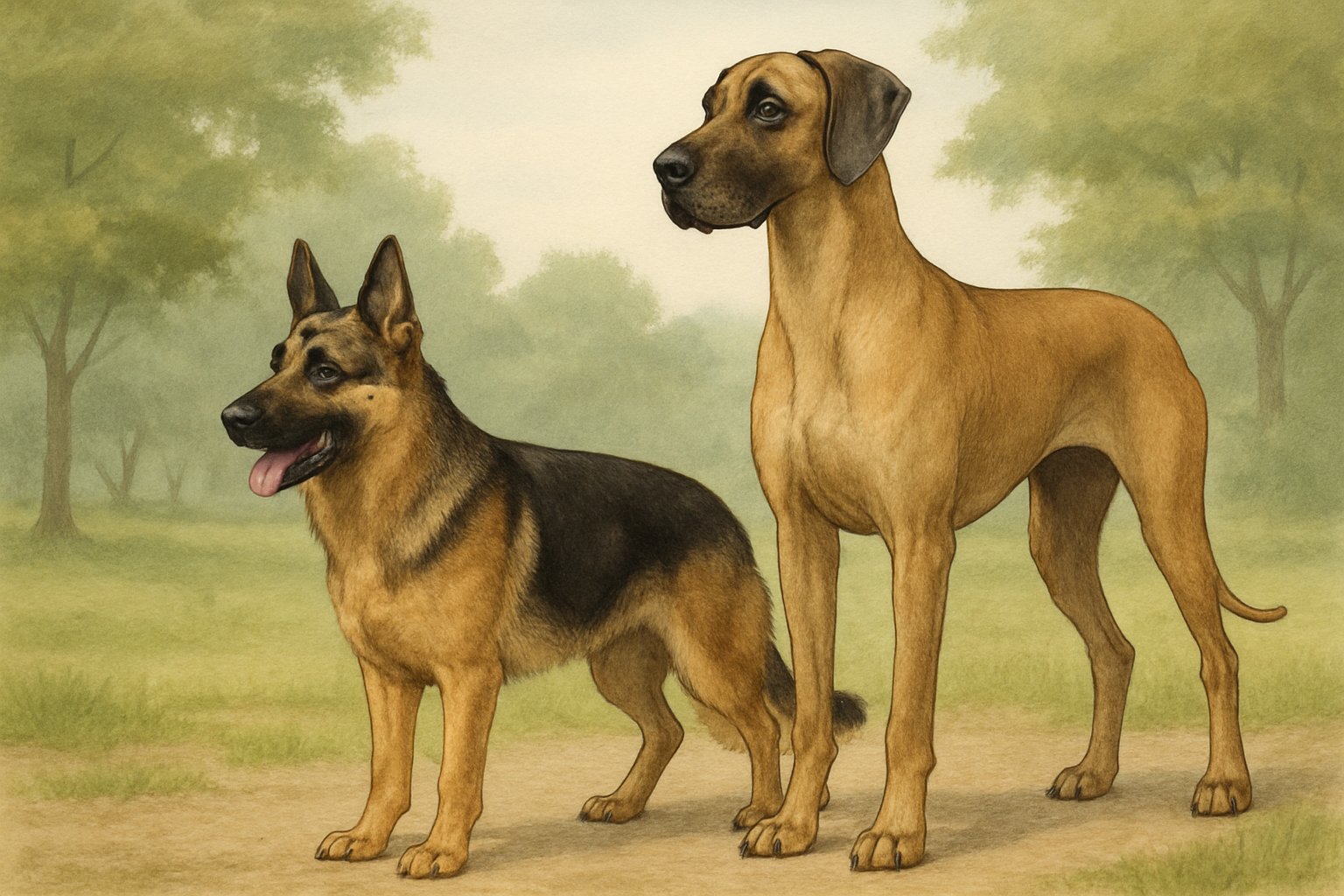
You might prefer a German Shepherd if you want a smart, active companion. Or maybe you’re drawn to the Great Dane’s relaxed, friendly nature.
Understanding their differences will help you make the right decision for your family.
Key Takeaways
- Each breed has a unique history and physical build.
- Temperament and health needs differ between German Shepherds and Great Danes.
- Training, care, and lifestyle should match your choice of breed.
Breed Origins and History
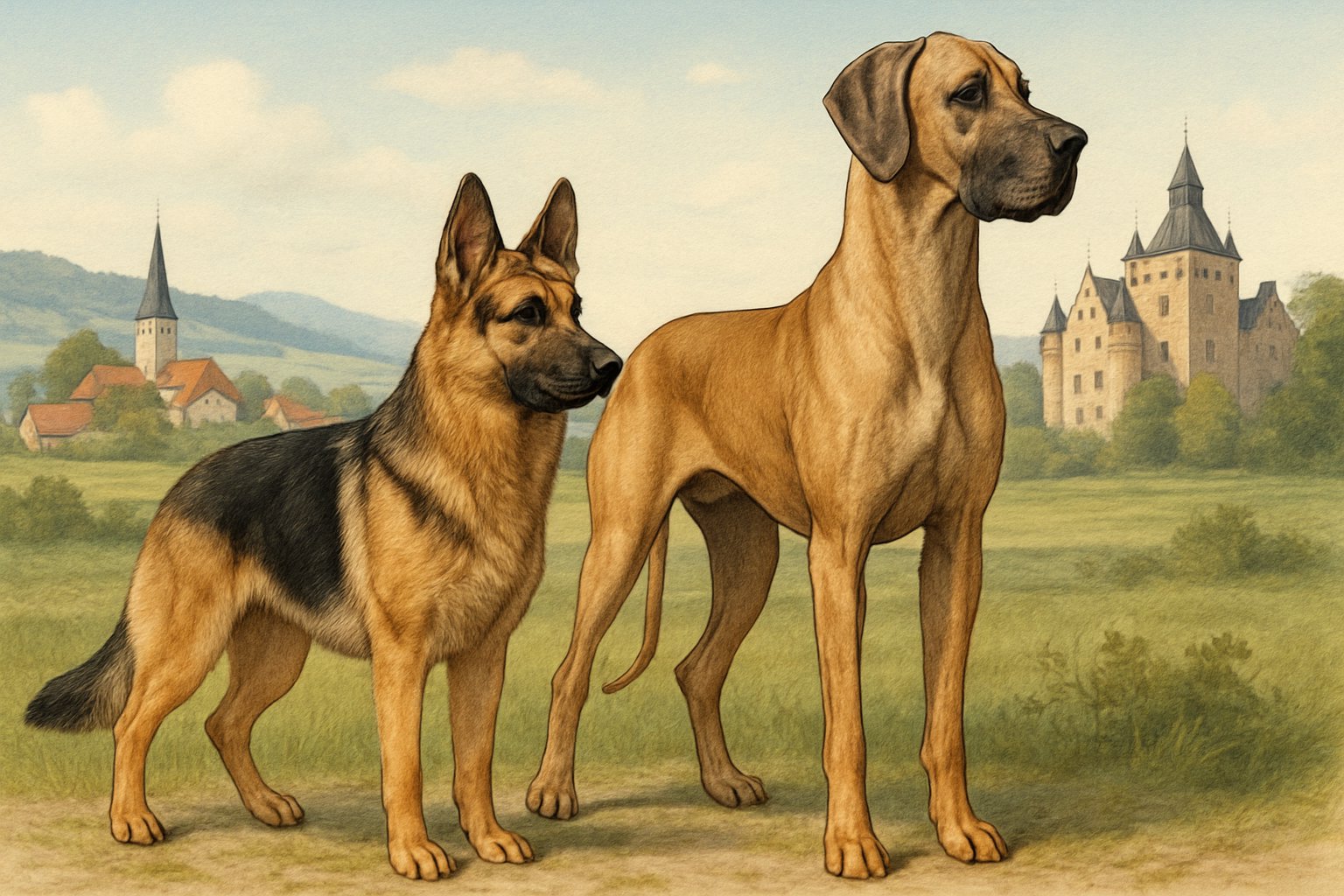
German Shepherds started out as herding and working dogs in Germany. Great Danes have a much older history as hunting and guard dogs in Europe.
Their backgrounds shape how they act and what they need from their owners.
German Shepherd Background
The German Shepherd came from Germany in the late 1800s. Max von Stephanitz set out to create a breed that combined intelligence, strength, and herding skills.
He picked dogs with the right traits and developed a dependable worker.
German Shepherds quickly proved themselves with police, military, and rescue teams. Their loyalty and trainability made them popular during both World Wars.
Today, German Shepherds are known for being alert, strong, and protective. They arrived in the United States in the early 1900s and became favorites for police and service work.
German Shepherds are also found in many homes as family pets.
Great Dane Heritage
The Great Dane goes way back—much older than the German Shepherd. Its roots reach into ancient times, when nobles in Germany and Denmark used them to hunt wild boar.
The breed probably comes from old mastiff and Irish wolfhound types. By the 16th century, Great Danes were estate guards and prestige symbols.
Their huge size and gentle nature earned them the nickname “gentle giants.” Nobles kept them around for protection and companionship, not just hunting.
Great Danes made their way to America in the late 1800s. People now love them for their calm and friendly attitudes.
Despite their size, they’re usually gentle with families and kids.
Physical Characteristics Comparison
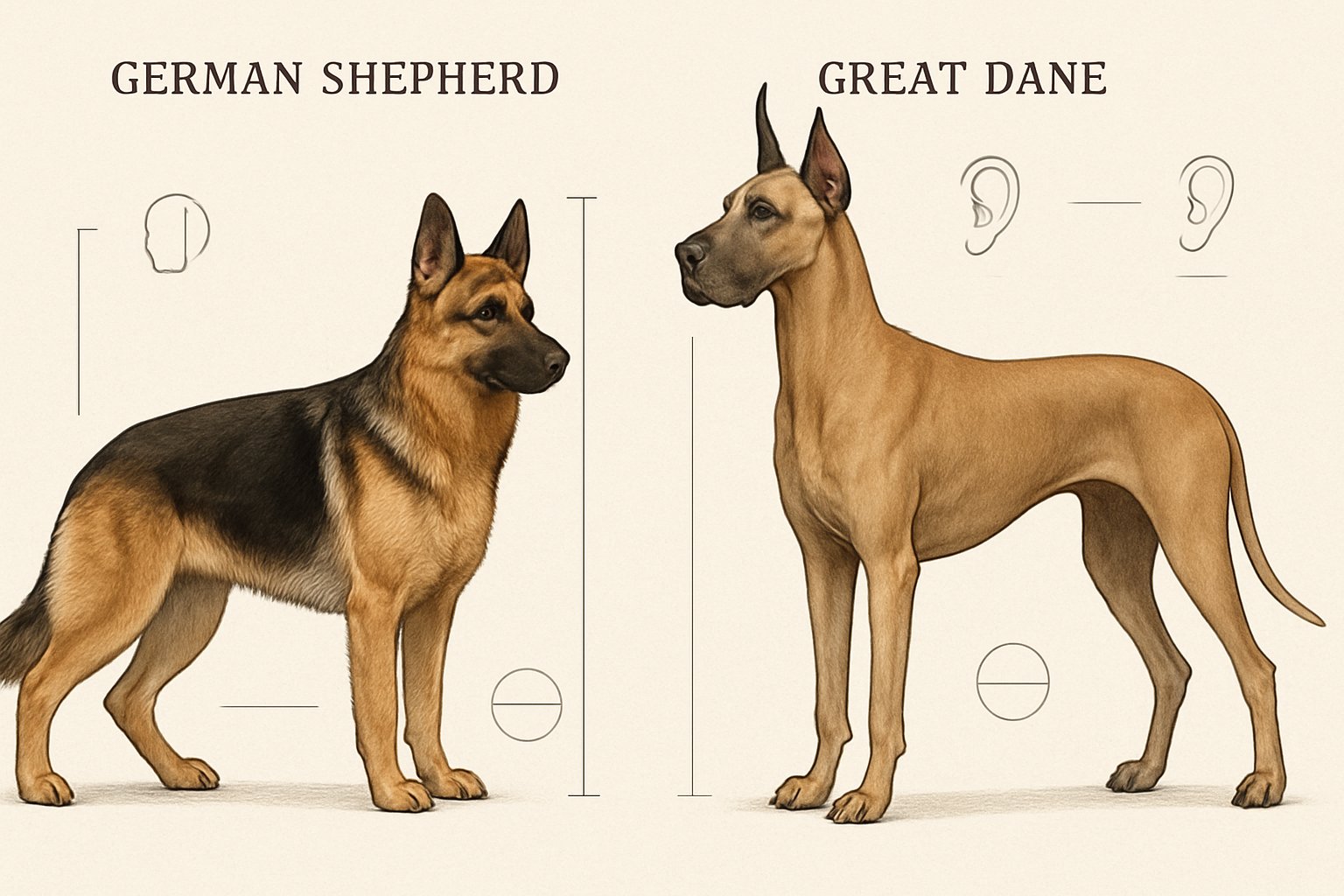
German Shepherds and Great Danes look nothing alike. Their size, coats, and body shapes make them easy to tell apart.
These differences affect care, living space, and how each dog fits into your life.
Size and Build
Great Danes are one of the tallest dog breeds out there. Most stand 28 to 34 inches at the shoulder and weigh 110 to 175 pounds or even more.
Males are usually bigger than females. German Shepherds are medium to large dogs, standing 22 to 26 inches tall and weighing 50 to 90 pounds.
That’s a big difference. Great Danes tower over German Shepherds, but both breeds are strong and sturdy.
Compared to breeds like the Irish Wolfhound or Saint Bernard, the Great Dane is still among the giants. German Shepherds are closer in size to the Bernese Mountain Dog.
Great Danes need more space to move around. They also cost more to feed and care for, thanks to their size.
Coat and Color Variations
German Shepherds have a double coat that can be medium or long. Their coats are dense and protect them from weather.
Most are black and tan, but you’ll see sable, black, or even all white German Shepherds sometimes. Great Danes have a short, smooth coat that hugs their bodies.
They come in colors like fawn, brindle, black, blue, harlequin (white with black patches), and mantle (black and white). If you’re sensitive to shedding, keep in mind that German Shepherds shed a lot and need regular brushing.
Great Danes shed too, but not as much. The Saint Bernard, like the German Shepherd, also has a thick double coat that sheds heavily.
Facial and Body Structure
German Shepherds look athletic, with a straight or slightly sloping back. Their ears stand up, and their eyes are almond-shaped.
They’ve got a long muzzle and a bushy tail that hangs down when they’re relaxed. Great Danes have a massive, muscular frame and a deep chest.
Their faces are long and rectangular, with a square jaw. Their ears are large and droopy (some people still crop them, but that’s less common now).
Their eyes are round and set deep. Compared to the Saint Bernard, Great Danes look leaner, while Saint Bernards are bulkier.
German Shepherds have sharp angles and tight muscles, looking agile and ready for action. Irish Wolfhounds are taller on average than Great Danes but look slimmer and more narrow.
Temperament and Behavior
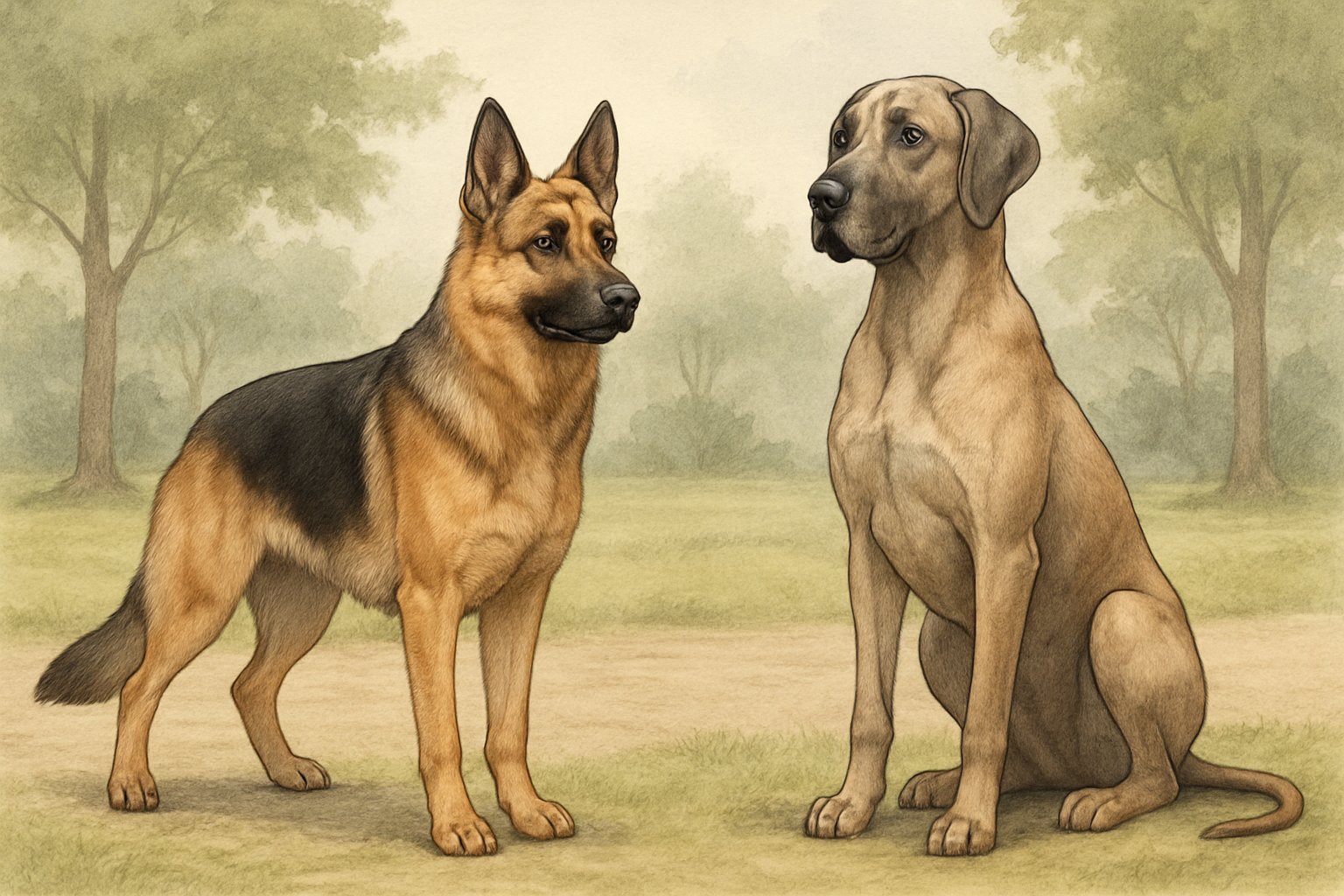
German Shepherds and Great Danes are both loved for their personalities, but their energy and attitudes are different. How do they act with families or other pets?
Family Compatibility
German Shepherds are loyal and protective. They usually bond closely with one person but love the whole family.
They do well with older kids and adults. Sometimes, their herding instincts make them nudge or gently herd smaller children.
Great Danes are gentle giants. They’re calm, patient, and tend to be less excitable than German Shepherds.
They usually fit right in with kids and can be tolerant with guests. Compared to breeds like the Labrador Retriever or Golden Retriever, both German Shepherds and Great Danes are a bit more reserved but still friendly at home.
Both breeds need confident owners who set clear rules. Dobermans, Boxers, and Rottweilers can be more intense, while breeds like the Shih Tzu or English Bulldog are less active and demanding.
Socialization and Interaction
German Shepherds stay alert and may act wary around new people or animals at first. Early socialization is key to prevent shyness or aggression.
They love training and need regular mental and physical challenges to stay happy. Great Danes are more laid-back with strangers and new pets.
They’re friendly, but their size can be intimidating if not managed well. Early socialization helps Great Danes stay calm and well-mannered.
Getting both breeds used to other pets—like a Chow Chow or Labrador Retriever—makes life easier. It also helps them handle new situations, whether you bring home a playful Boxer or a quieter breed like an English Bulldog.
Both breeds respond best to positive reinforcement and a patient approach.
Health Issues and Lifespan
German Shepherds and Great Danes both face unique health challenges. Knowing the common issues and typical lifespan helps you plan for their care.
Common Health Problems
Both breeds deal with joint and bone issues, like hip and elbow dysplasia. These can cause pain and limit movement as dogs age.
Arthritis is also common in older dogs of both breeds. Bloat (gastric dilatation volvulus) is a serious risk for both German Shepherds and Great Danes.
It’s life-threatening and needs emergency care. Eating too fast, large meals, and stress can make it more likely.
Heart problems pop up, too. Dilated cardiomyopathy often affects large breeds and can lead to heart failure.
Keeping your dog at a healthy weight and scheduling regular check-ups can lower some risks.
Breed-Specific Concerns
German Shepherds are more likely to develop degenerative myelopathy, a nerve disease that weakens or paralyzes the back legs. They can also get exocrine pancreatic insufficiency, which causes trouble digesting food.
Great Danes face higher risk for dilated cardiomyopathy (heart disease) and osteosarcoma (bone cancer). Their size makes them especially prone to bloat.
Big, deep-chested breeds like Great Danes, Great Pyrenees, and Cane Corsos all share these risks. Watch for symptoms and get regular vet checks.
Some problems can be caught early and managed with the right care.
Life Expectancy
German Shepherds usually live 9 to 13 years if they stay healthy. Good food, exercise, and vet care help them reach the higher end of that range.
Great Danes have a shorter lifespan, averaging 7 to 10 years. Their size puts more strain on their organs and joints, which can shorten their lives.
Comparison Table:
| Breed | Average Lifespan | Major Risks |
|---|---|---|
| German Shepherd | 9–13 years | Hip dysplasia, myelopathy |
| Great Dane | 7–10 years | Bloat, cardiomyopathy, cancer |
Regular vet care and a healthy lifestyle give your dog a better shot at a longer, happier life. Pay attention to changes in behavior or health, and don’t wait to get help if something seems off.
Care, Training, and Nutrition
German Shepherds and Great Danes both need daily exercise, some grooming, and a balanced diet. Their care and training needs aren’t quite the same, though.
Exercise and Training Needs
German Shepherds are active and smart. They need about 1-2 hours of physical activity every day—think walks, runs, or fetch.
Training is a must, since bored Shepherds can pick up bad habits fast. Great Danes are much bigger but don’t have the same energy level.
They’re happy with daily walks and a bit less activity overall. Both breeds benefit from early socialization and obedience training.
Training Tips:
- Start early with short, positive sessions.
- Be consistent with commands and rewards.
- Socialize them with people and other dogs—especially large and mixed breeds.
German Shepherds often pick up commands quickly, but patience pays off with both breeds. Some folks compare Great Danes’ personalities to Labrador Retrievers—they’re calm, but their size means you need to teach leash manners right away.
Grooming Routines
German Shepherds have a double coat and shed all year, with heavy shedding twice annually. Brush them several times a week to keep fur under control.
Great Danes have short, smooth fur and don’t shed as much. Once-a-week brushing usually does the trick.
Bathing can be done every few months or when needed, depending on how active they are.
Grooming Quick List:
- German Shepherds: Brush 3-4 times per week, check ears, trim nails monthly.
- Great Danes: Brush weekly, check skin for irritation, trim nails as needed.
Brush both breeds’ teeth regularly. Regular grooming helps you spot health problems early, too.
Diet and Nutritional Needs
German Shepherds and Great Danes have pretty different nutritional needs. Their size and energy levels really set them apart.
German Shepherds do well with high-quality dog food that has real meat, grains, and vegetables. They need plenty of protein to keep their muscles and joints in good shape.
Great Danes need food made for large or giant breeds. This helps support their bones and joints as they grow and age.
Overfeeding a Great Dane? Not a great idea. It can lead to health issues like bloat, so it’s better to feed them smaller meals a few times a day instead of one big one.
| Breed | Typical Adult Weight | Calories/day* | Meal Frequency |
|---|---|---|---|
| German Shepherd | 50-90 lbs | 1500-2100 | 2 times daily |
| Great Dane | 110-175 lbs | 2500-3700 | 2-3 small meals daily |
*calories vary by age and activity level
Pick high-quality food with glucosamine and chondroitin for both breeds. These ingredients help support joint health.
Always keep fresh water available. Avoid giving them table scraps since it can mess up their diet and lead to weight gain.

